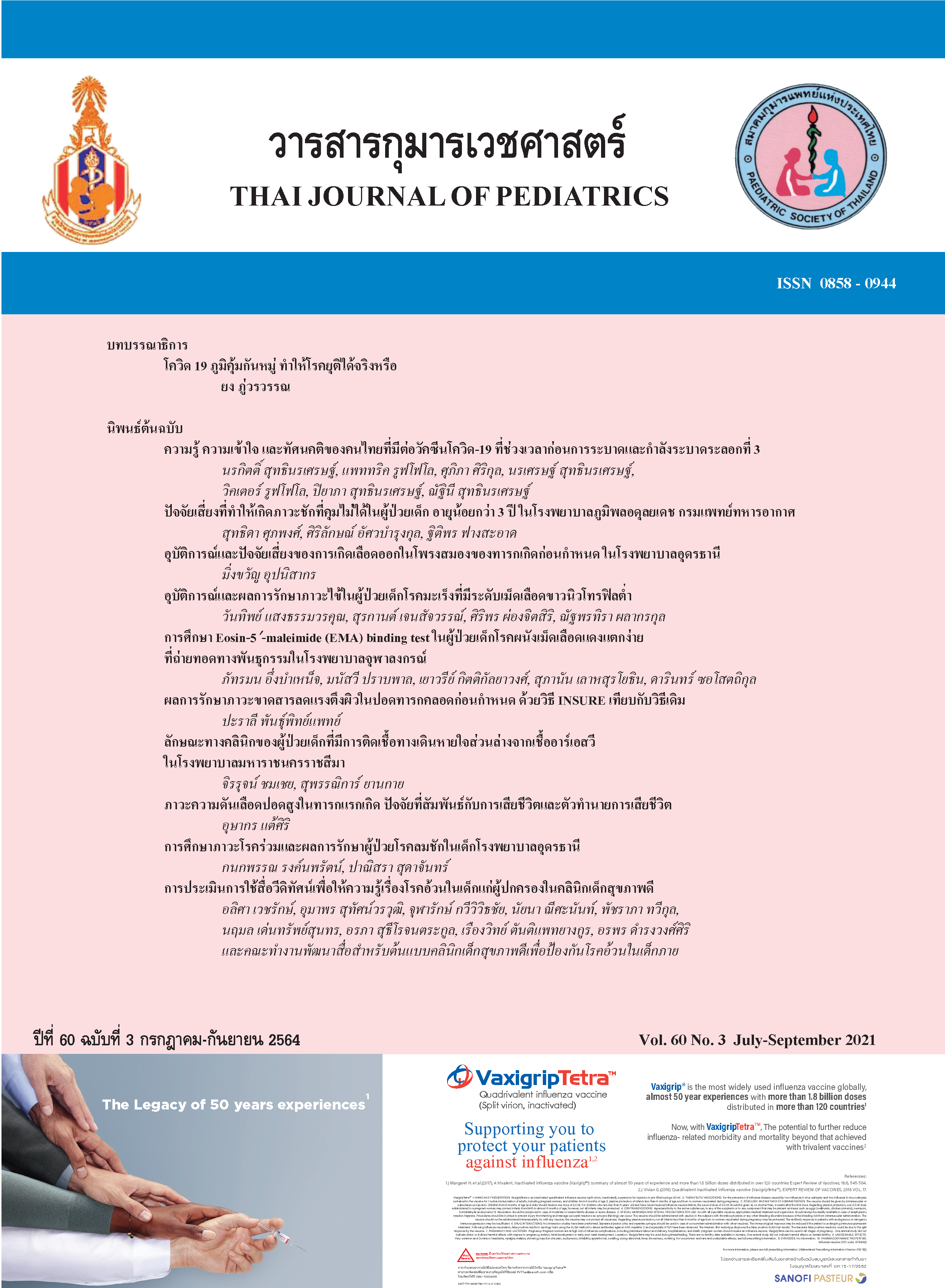การศึกษาภาวะโรคร่วมและผลการรักษา ผู้ป่วยโรคลมชักในเด็กโรงพยาบาลอุดรธานี
คำสำคัญ:
โรคลมชักในเด็ก, ภาวะโรคร่วมของผู้ป่วยโรคลมชัก, ผลการรักษาบทคัดย่อ
บทนำ : โรคลมชักเป็นปัญหาสำคัญทางประสาทวิทยาในเด็กผู้ป่วยโรคลมชักเด็กมักมีภาวะโรคร่วมที่ส่งผลต่อพัฒนาการและสติปัญญายังไม่มีการรายงานภาวะโรคร่วมและผลการรักษาในเด็กมาก่อน
วัตถุประสงค์ : เพื่อศึกษาภาวะโรคร่วมของโรคลมชักในผู้ป่วยเด็กโรงพยาบากอุดรธานีและเปรียบเทียบผลการรักษาระหว่างผู้ป่วยเด็กโรคลมชักที่มีภาวะโรคร่วมกับไม่มีภาวะโรคร่วม
วิธีการศึกษา : การศึกษาย้อนหลังรวบรวมข้งมูลจากเวชระเบียนผู้ป่วยเด็กที่ได้รับการวินิจฉัยว่าเป็นโรคลมชักในโรงพยาบาลอุดรธานี ระหว่างมกราคม 2561 ถึง ธันวาคม 2561 และมาติดดามการรักษาต่อเนื่องเก็บข้อมูถพื้นฐานและข้อมูลโรคลมชัก ภาวะโรคร่วมและผลการรักษาวิเคราะห์ข้อมูลโดยใช้โปรแกรมสำเร็จรูปทางสถิติ STATA (version 15)
ผลการศึกษา : ผู้ป่วย 401 ราย เพศชาช 217 ราย (ร้อยถะ 54.11) อายุเฉลี่ย 8 ปี 9 เดือน ระยะเวลาที่เป็นโรคลมชักเฉลี่ย 3 ปี 4 เดือน พบภาวะโรคร่วมร้อยละ 47.4 (Intellectual disabiliy ร้อยละ 38.7 cercbral palsy ร้อยละ 15.7 แถะ ADHD ร้อยละ 4.7) ผลหลังรักษาด้วยยาครั้งแรกผู้ป่วยหยุดชักภายใน 2 ปี 243 ราย (ร้อยละ60.75) ผู้ป่วย 44 ราย (ร้อยละ 10.97) จำนวนการชักลดลงจากเดิมได้ไม่ถึงครึ่ง (Seizure reduction<50%) เปรียบเทียบพบว่ากลุ่มที่มีภาวะโรคร่วมมีอายุเฉลี่ย ระยะเวถาที่เป็นโรคลมชัก และผลการรักษาแตกต่างจากกลุ่มที่ไม่มีภาวะโรคร่วมอย่างมีนัยสำคัญ (p-value < 0.05)
สรุป : ผู้ป่วยมีภาวะโรคร่วมร้อยละ 47.4 ภาวะโรคร่วมที่พบมาก ได้แก่ Intellectual disability Cerebral Palay และ ADHD ผู้ป่วยที่มีภาวะโรคร่วมมีผลการรักษาแย่กว่าผู้ป่วยที่ไม่มีภาวะโรคร่วมอย่างมีนัยสำคัญทางสถิติ (p-value <0.05)
Downloads
เอกสารอ้างอิง
WHO News releases/facts sheets (2018). Epilepsy (online) Availableat:URL:https://www.who.int/news-room/fact-sheets/detail/epilepsy. Accessed February 8, 2018
Subchartanan J, Patharathitikul S, Chonchaiya W. Prevalence of attention deficit hyperactivity disorder in children with epilepsy in a Thai Hospital. Asian Biomedicine 2015; 9 : 803-7.
Aaberg KM, Bakken IJ, Lossius IM, et al. Comorbidity and Childhood Epilepsy: A Nationwide Registry Study. Pediatrics 2016;
(3);
Keezer MR, Sisodiya SM, Sander JW. Comorbidities of epilepsy: current concepts and future perspectives. Lancet Neurol. 2016;15:106-15.
Baca CB, Vickrey BG, Caplan R, Vassar SD, Berg AT. Psychiatric and medical comorbidity and quality of life outcomes in childhood-onset epilepsy.Pediatrics. 2011 Dec;128:e1532-436. Gilliam F, Hecimovic H, Sheline Y. Psychiatric comorbidity, health, and function in epilepsy.EpilepsyBehav. 2003 Dec;4 Suppl 4:S26-30.
Sillanpaa M, Anttinen A, Rinne JO, et al. Childhood-onset epilepsy five decadeslater.A prospective populationbasedcohort study.Epilepsia.2015;56:1774–1783
Camfield C, Camfield P, Smith B. Poorversus rich children with epilepsyhave the same clinical course andremission rates but a less favorablesocial outcome: a population-basedstudy with 25 years of follow-up.Epilepsia. 2016;57:1826–1833
Geerts A, Arts WF, Stroink H, et al.Course and outcome of childhoodepilepsy: a 15-year follow-up of theDutch study of epilepsy in childhood.Epilepsia. 2010;51:1189–1197
Berg AT, Rychlik K, Levy SR, Testa FM.Complete remission of childhoodonsetepilepsy: stability and
predictionover two decades. Brain. 2014;137:3213–3222
Sillanpaa M, Schmidt D. Earlyseizure frequency and aetiologypredict long-term medical outcome in childhood-onset epilepsy. Brain.2009;132(pt 4):989–998
Gaitatzis A, Carroll K, Majeed A, W Sander J.The epidemiology of the comorbidity of epilepsy in the general population.Epilepsia. 2004;45:1613-22.
Keezer MR, Sisodiya SM, Sander JW. Comorbidities of epilepsy: current concepts and future perspectives. Lancet Neurol. 2016;15:106-15. Erratum in: Lancet Neurol. 2016;15:28.
ดาวน์โหลด
เผยแพร่แล้ว
รูปแบบการอ้างอิง
ฉบับ
ประเภทบทความ
สัญญาอนุญาต

อนุญาตภายใต้เงื่อนไข Creative Commons Attribution-NonCommercial-NoDerivatives 4.0 International License.



